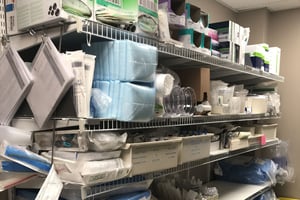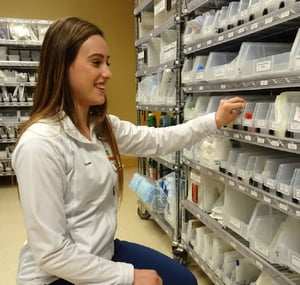
Adopting a new software platform will likely be a crucial decision hospitals and IDNs make at some juncture. Many hospitals have decided to take the leap from traditional client-server ERP systems to cloud-based platforms for managing their supply room inventory. When evaluating these platforms and planning to move forward on the project, it is incredibly important to pay attention to some key areas. This sets the project on a smooth transition to the new platform and ensures the organization benefits from increased efficiency, open accessibility, time savings, and a positive impact on its bottom line. Industries are riddled with tales of good projects gone bad because of bad processes, poor data governance, and lacking a Center of Excellence team. These are just a few areas that plague many software implementations.
Many of our client hospitals and health systems are implementing, or transitioning, to cloud-based versions of their ERP with the idea that it can address multiple pain points throughout the organization. But these huge undertakings/applications are far from a technology fix-all. We understand that an ERP’s strong suit is usually a financial backbone with functionality for purchasing and HR, leaving supply chain efficiency and management nearly an afterthought.
“A cross-functional CoE team is particularly important because there are decisions you need to make that are, well, cross-functional. A decision that the Supply Chain group makes could have an impact on Finance or HR, or even clinicians and nursing staff,” says Aaron Eden CMRP, CSM, and Principal Consultant for Alpha Echo Consulting. “It is paramount to the success of this type of project to have a team which is open, honest, and can make decisions for the organization as a whole.”
As you begin to evaluate cloud-based ERP software and build out a COE, Eden advises, “Sometimes organizations rely on the implementation team a little too much and forget about training their staff. They go live and the consultants say, ‘see you later,’ and their employees have no idea what to do! Avoid the hassle and expense of paying an additional contract to a consultant before you ever go live.”
Eden also notes, “It is also important to think through the strategic positions that may be necessary to fix any errors without having to hire anyone from the outside, i.e., IT or technical people. Sometimes they have zero visibility; no dashboards or homegrown systems could be outdated. Change management is a huge deal!”
It is important to be sure the solutions you assess address the following areas.
Procurement
A new system should allow you to manage purchasing with ease. One system which manages the information, policies, and processes needed for purchasing goods and services.
Gone are the days of capturing and processing supplier invoices manually. A new solution should provide a methodology for this work to be done in a more automated fashion, allowing users to focus on more strategic initiatives.
The new platform should also increase your understanding of where the organization’s money goes. A good ERP allows you to analyze the data to better understand overall spending and create or adjust policies as needed, creating a streamlined procurement process.
Supply chain functionality is simply a byproduct that feeds the financials. ERPs typically fall short of providing the appropriate level of inventory management, PAR optimization, demand forecasting, and point-of-care functionality needed to meet the extremely complex supply chain requirements of today’s health systems.
![]()
Inventory

ERPs commonly claim to provide end-to-end inventory management which makes it easy to stock, track, and replenish internal goods and supplies.
To ensure stock, tracking, and replenished items needed to support patient care, ERP systems claim that they will give you the visibility needed to manage costs and optimize stock levels. They can help, but only to a degree. The new solution should allow you to:
- Quickly adapt to changing conditions in inventory sites or stock locations, PAR levels, and more
- Minimize operational risk with automated replenishment, receipt, and put-away
- Focus on tools that will help you maintain inventory at the point of care by stocking and counting PAR levels, Kanban, and perpetual locations
- Increase productivity with real-time, actionable insights accessible from any device
At a high level, ERPs typically cannot provide complete visibility for multiple inventory locations in a hospital or across the wide variety of products used throughout an IDN. In addition, they cannot provide a real-time overview of actual consumption. An ERP system will not be able to manage what is happening in the Cath Lab, OR, or other procedural areas when it comes to effective data capture. It simply cannot address the specific needs of these important and complex environments at the clinician’s point of use. This makes ERPs ineffective not only for the materials management team but also for the clinical staff that needs to integrate their dynamic workflow with supply chain requirements.
Strategic Sourcing
A good strategic sourcing analytics module will give you the ability to become a strategic partner with vendors, distributors, and internal departments.
You will want to engage stakeholders and suppliers to drive collaboration to deliver results. While any competent ERP connects the enterprise to sourcing in a single platform, additional sourcing benefits can be found to supplement your ERP, such as BlueQ SmartScan's Supplier Returns solutions.
The platform should also allow you to negotiate better deals by facilitating pricing conversations through real-time data and analysis. Get rid of those spreadsheets!
Make sure the new cloud-based ERP can streamline the source-to-contract process, maximize supplier impact, and drive better outcomes. Exceed savings targets and improve supplier compliance.
Close the sourcing loop with a single system or minimal complimentary systems.
Reporting & Analytics
There really is no point in just storing a bunch of data and doing nothing with it. It becomes more powerful when you put the data to work and derive real reports and insights with which to improve your processes and procedures. Too many organizations fall into the big data trap. The amount of data is usually overwhelming, and it is rarely, if ever, used to grow and improve upon. A robust and dynamic solution helps hospital staff and leaders understand exactly what happened when, where, and why.
While ERPs say they will provide reporting and analytics capabilities, they are usually overstated. Make sure it answers all your strategic and operational questions. Before you transition, bring together the information you need to make the best supply chain decisions.
Use data to drive standardization and contract compliance and uncover opportunities to reduce costs.
A Better Solution

A new ERP is an enormous undertaking, do not go in blind. You will still most likely need a great point-of-use solution that will bridge the gap between clinical and supply chain, building long-lasting trust between the inventory/materials team and the clinicians. This adherence also builds an integration between the two groups with a focus on better:
- Managing both inventory and the overall supply chain
- Supply costs
- Patient success
- Nursing job satisfaction
BlueBin’s BlueQ Analytics and SmartScan focus on data capture, which is key at the point of use to automate and improve logistic processes, provide real-time visibility of supply-demand, and take the nurses and other clinical staff out from beneath the manual, inventory-related activities. A good SCM solution will give nurses and clinicians 100% of their time back to patient care, which indirectly leads to higher patient satisfaction.
PAR Optimization is KEY – BlueQ Analytics and SmartScan ensure data-driven efficiency with:
- Spend & Volume Dashboards & Reports
- Warehouse Management Dashboards & Reports
- Sourcing & Procurement Dashboards
- Real-Time PAR Management Reports
- Assessable from any Internet Enabled Device
- Detailed Item, PAR, & Location Velocity Dashboards
- Stock/Bin Rotation Metrics
- Predictive Stock-Out & Surplus Management Reports
- Voice of the Customer (QCN) Portal
- Standard Work & Node Audit Functionality
- Daily Management Huddle Board
- Labor/Time Management Dashboards
- Aggregate Data-Bin Sizing & Utilization Metrics
- Aggregate Data-Spend Management/Optimization Reports
Before undertaking a major investment in a generic ERP system, perhaps it is time to look at a Supply Chain Management solution purpose-built for healthcare instead. BlueQ SmartScan application is designed to replace aged and expensive ERP handhelds with a great deal of added functionality. Ordering and receiving supplies, route control functionality, warehouse management tools, and easy access to the BlueQ Analytics suite from anywhere means SmartScan is perfect for healthcare organizations implementing a Kanban pull system. Or simply those organizations who wish to give their traditional PAR replenishment systems a turbo boost!
